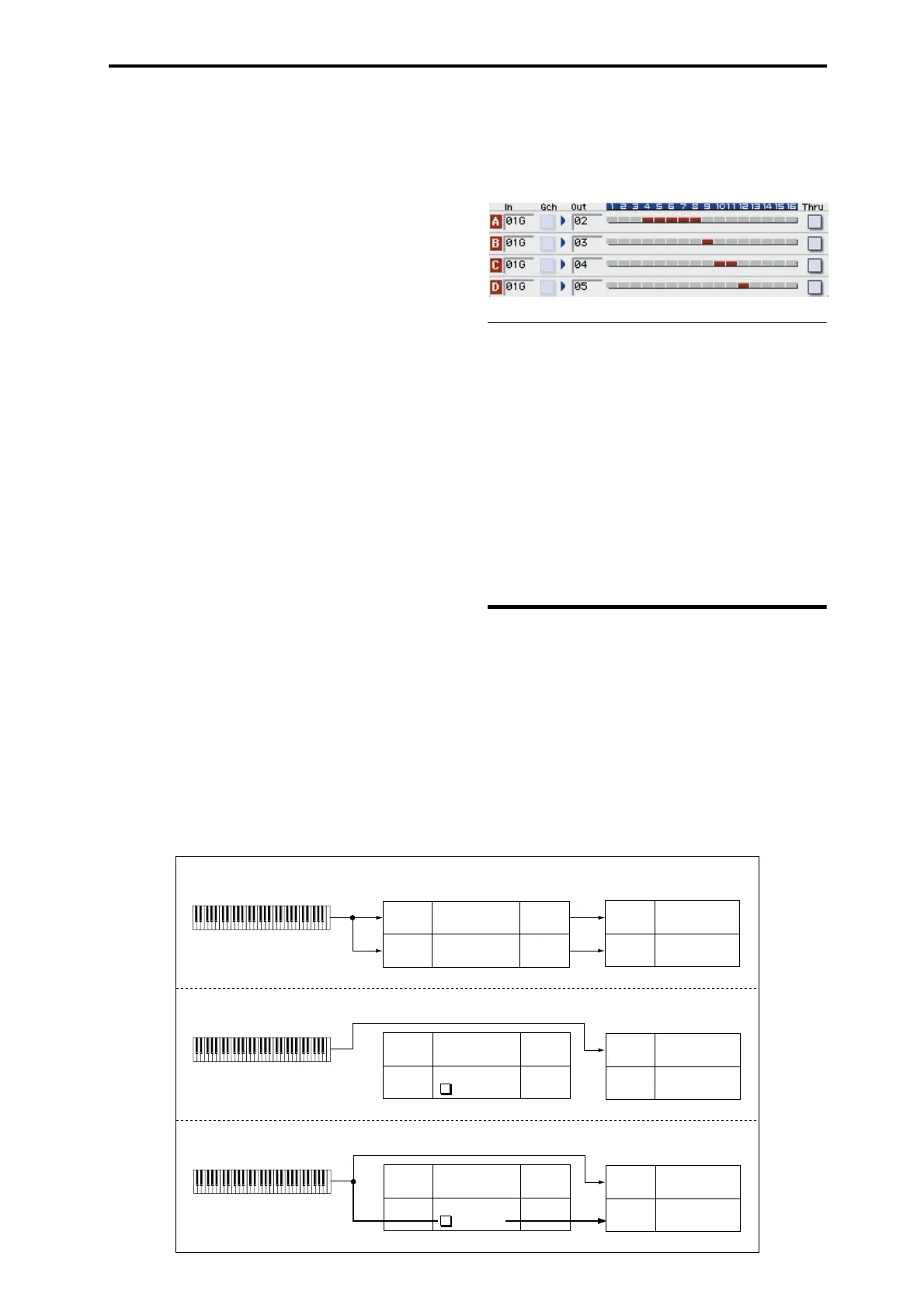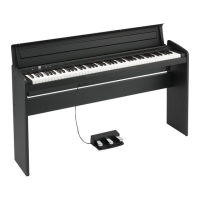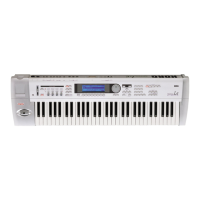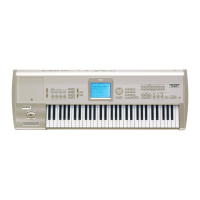COMBI P7–1: KARMA 1 7–1–2: GE Setup B, 7–1–3: GE Setup C, 7–1–4: GE Setup D
163
5. Set KARMA Module [B] as follows.
GE Select: Any riff from the Keyboard GE category
In (Input Channel): Gch
Out (Output Channel): 02
Timbre Thru: Off
6. Turn the KARMA ON/OFF switch on.
When you play the keyboard, KARMA Module [A] will play
the bass of timbre 1, and KARMA Module [B] will play the
piano of timbre 2. (See “KARMA ON/OFF=ON (1)(2)” in
the diagram below.)
7. Turn the KARMA ON/OFF switch off.
When you play the keyboard, you will hear the bass of
timbre 1, whose MIDI channel is set to Gch. Since timbre 2 is
set to MIDI channel 2, it will not sound in response to the
keyboard. (See “KARMA ON/OFF=OFF (1)” in the
diagram below.)
Example setting 2
1. Follow steps 1–3 from Example setting 1, above.
2. Set KARMA Module [A] as follows.
GE Select: Any riff from the Bass GE category
In (Input Channel): Gch
Out (Output Channel): Gch
Thru: Off
3. Set KARMA Module [B] as follows.
GE Select: Any riff from the Keyboard GE category
In (Input Channel): Gch
Out (Output Channel): 02
Thru: On
4. Turn the KARMA ON/OFF switch on.
When you play the keyboard, the result will be the same as
for step 6 in Example setting 1. (See “KARMA ON/
OFF=ON (1)(2)” in the diagram below.)
5. Turn the KARMA ON/OFF switch off.
When you play the keyboard, you will hear the bass timbre,
whose MIDI channel is Gch. The piano of timbre 2 will also
be played by the keyboard because of the Timbre Thru On
setting of KARMA Module [B]. (See “KARMA ON/
OFF=OFF (2)” in the diagram below.)
Module – Timbre MIDI Display:
This shows the timbres that will be sounded by each
KARMA Module, according to the MIDI output channel
settings of each KARMA Module and the MIDI channel of
each timbre (Combi 3–1(2)c: MIDI Channel).
▼7–1–1: Menu Command
• 0: Write Combination ☞p.185
• 1: Panel–SW Solo Mode On ☞p.106
• 2: Exclusive Solo ☞p.107
• 3: Copy KARMA Module ☞p.114
• 4: Initialize KARMA Module ☞p.115
• 5: Copy Scene ☞p.115
• 6: Swap Scene ☞p.115
• 7: Capture Random Seed ☞p.116
• 8: Copy from Program ☞p.185
For more information, please see “Combination: Menu
Command” on page 185.
7–1–2: GE Setup B,
7–1–3: GE Setup C,
7–1–4: GE Setup D
These are the same as “7–1–1: GE Setup A.”
For more information, please see “7–1–1: GE Setup A” on
page 161.
KARMA Module [A]
In : Gch
Out : Gch
KARMA Module [B]
In : Gch Out : 02ch
KARMA ON/OFF = ON (1) (2)
Timbre 1: BassIn : Gch
Timbre 2: Piano
In : 02ch
KARMA Module [A]
In : Gch
Out : Gch
In : Gch
Out : 02ch
Timbre 1: Bass
In : Gch
Timbre 2: Piano
In : 02ch
KARMA Module [B]
Timber Thru
KARMA ON/OFF = OFF (1)
KARMA Module [A]
In : Gch
Out : Gch
In : Gch
Out : 02ch
Timbre 1: Bass
In : Gch
Timbre 2: Piano
In : 02ch
KARMA Module [B]
Timber Thru
■
KARMA ON/OFF = OFF (2)

